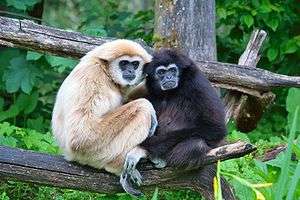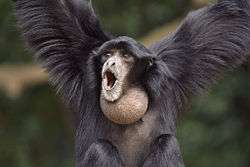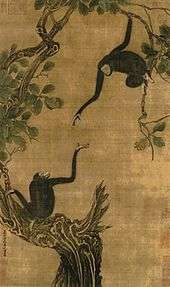Gibbon
| Gibbons[1][2] Temporal range: 8–0 Ma Late Miocene–Recent | |
|---|---|
 | |
| Lar gibbons (Hylobates lar) | |
| Scientific classification | |
| Kingdom: | Animalia |
| Phylum: | Chordata |
| Class: | Mammalia |
| Order: | Primates |
| Suborder: | Haplorhini |
| Superfamily: | Hominoidea |
| Family: | Hylobatidae Gray, 1870 |
| Type genus | |
| Hylobates | |
| Genera | |
 | |
| Distribution in Southeast Asia | |
Gibbons are apes in the family Hylobatidae. The family historically contained one genus, but now is split into four genera and 17 species. Gibbons occur in tropical and subtropical rainforests from eastern Bangladesh and northeast India to southern China and Indonesia (including the islands of Sumatra, Borneo, and Java).
Also called the smaller apes or lesser apes,[3] gibbons differ from great apes (chimpanzees, bonobos, gorillas, orangutans, and humans) in being smaller, exhibiting low sexual dimorphism, and not making nests. In certain anatomical details, they superficially more closely resemble monkeys than great apes do, but like all apes, gibbons are tailless. Gibbons also display pair-bonding, maintaining the same mate for life, unlike most of the great apes (this has been disputed by Palombit and others, who have found that gibbons might be socially monogamous, with occasional "divorce", but not sexually monogamous[4][5]). Gibbons are masters of their primary mode of locomotion, brachiation, swinging from branch to branch for distances up to 15 m (50 ft), at speeds as high as 55 km/h (34 mph). They can also make leaps up to 8 m (26 ft), and walk bipedally with their arms raised for balance. They are the fastest and most agile of all tree-dwelling, nonflying mammals.[6]
Depending on species and sex, gibbons' fur coloration varies from dark to light brown shades, and any shade between black and white, though a completely "white" gibbon is rare.
Gibbon species include the siamang, the white-handed or lar gibbon, and the hoolock gibbons.
Evolutionary history
Whole genome molecular dating analyses indicate that the gibbon lineage diverged from that of great apes around 16.8 million years ago (Mya) (95% confidence interval: 15.9 – 17.6 Mya; given a divergence of 29 Mya from monkeys).[7] Adaptive divergence associated with chromosomal rearrangements led to rapid radiation of the four genera 5-7 Mya. Each genus comprises a distinct, well-delineated lineage, but the timing and sequence of divergence among these genera remains unresolved, even with whole genome data, due to extensive incomplete lineage sorting.[7][8] At the species level, estimates from mitochondrial DNA genome analyses suggest that Hylobates pileatus diverged from H. lar and H. agilis around 3.9 Mya, and H. lar and H. agilis separated around 3.3 Mya.[8] Whole genome analysis suggests divergence of Hylobates pileatus from Hylobates moloch 1.5-3.0 Mya.[7] The extinct Bunopithecus sericus is a gibbon or gibbon-like ape which, until recently, was thought to be closely related to the hoolock gibbons.[2]
Taxonomy





The family is divided into four genera based on their diploid chromosome number: Hylobates (44), Hoolock (38), Nomascus (52), and Symphalangus (50).[2][9]
- Family Hylobatidae: gibbons[1][9][10]
- Genus Hoolock
- Western hoolock gibbon, H. hoolock
- Eastern hoolock gibbon, H. leuconedys
- Genus Hylobates: dwarf gibbons
- Lar gibbon or white-handed gibbon, H. lar
- Malaysian lar gibbon, H. l. lar
- Carpenter's lar gibbon, H. l. carpenteri
- Central lar gibbon, H. l. entelloides
- Sumatran lar gibbon, H. l. vestitus
- Yunnan lar gibbon, H. l. yunnanensis
- Bornean white-bearded gibbon, H. albibarbis
- Agile gibbon or black-handed gibbon, H. agilis
- Müller's Bornean gibbon, H. muelleri
- Müller's gray gibbon, H. m. muelleri
- Abbott's gray gibbon, H. m. abbotti
- Northern gray gibbon, H. m. funereus
- Silvery gibbon, H. moloch
- Western silvery gibbon or western Javan gibbon, H. m. moloch
- Eastern silvery gibbon or central Javan gibbon, H. m. pongoalsoni
- Pileated gibbon or capped gibbon, H. pileatus
- Kloss's gibbon, Mentawai gibbon or bilou, H. klossii
- Lar gibbon or white-handed gibbon, H. lar
- Genus Symphalangus
- Siamang, S. syndactylus
- Genus Nomascus: crested gibbons
- Northern buffed-cheeked gibbon, N. annamensis
- Concolor or black crested gibbon, N. concolor
- N. c. concolor
- N. c. lu
- N. c. jingdongensis
- N. c. furvogaster
- Eastern black crested gibbon or Cao Vit black crested gibbon, N. nasutus
- Hainan black crested gibbon, N. hainanus
- Northern white-cheeked gibbon, N. leucogenys
- Southern white-cheeked gibbon, N. siki
- Yellow-cheeked gibbon, N. gabriellae
- Genus Hoolock
Hybrids
Many gibbons are hard to identify based on fur coloration, so are identified either by song or genetics.[11] These morphological ambiguities have led to hybrids in zoos. Zoos often receive gibbons of unknown origin, so they rely on morphological variation or labels that are impossible to verify to assign species and subspecies names, so separate species of gibbons commonly are misidentified and housed together. Interspecific hybrids, hybrids within a genus, are also suspected to occur in wild gibbons where their ranges overlap.[12] However, no records exist of fertile hybrids between different gibbon genera, either in the wild or in captivity.[7]
Physical description
One unique aspect of a gibbon's anatomy is the wrist, which functions something like a ball and socket joint, allowing for biaxial movement. This greatly reduces the amount of energy needed in the upper arm and torso, while also reducing stress on the shoulder joint. Sometimes, when a gibbon is swinging, its wrist naturally dislocates until the gibbon finishes its swing. Gibbons also have long hands and feet, with a deep cleft between the first and second digits of their hands. Their fur is usually black, gray, or brownish, often with white markings on hands, feet, and face. Some species have an enlarged throat sac, which inflates and serves as a resonating chamber when the animals call. This structure can become quite large in some species, sometimes equaling the size of the animal's head. Their voices are much more powerful than that of any human singer, although they are at best half a man's height.[13]
Gibbon skulls and teeth resemble those of the great apes, and their noses are similar to those of all catarrhine primates. The dental formula is 2.1.2.32.1.2.3 [14] The siamang, which is the largest of the 17 species, is distinguished by having two fingers on each foot stuck together, hence the generic and species names Symphalangus and syndactylus.[15]
Behavior

Gibbons are social animals. They are strongly territorial, and defend their boundaries with vigorous visual and vocal displays. The vocal element, which can often be heard for distances up to 1 km (0.6 mi), consists of a duet between a mated pair, with their young sometimes joining in. In most species, males and some females sing solos to attract mates, as well as advertise their territories.[16] The song can be used to identify not only which species of gibbon is singing, but also the area from which it comes.[17]
Gibbons are masters of their primary mode of locomotion, brachiation, swinging from branch to branch for distances up to 15 m (50 ft), at speeds as high as 55 km/h (34 mph).[18] The gibbons' ball-and-socket joints allow them unmatched speed and accuracy when swinging through trees. Nonetheless, their mode of transportation can lead to hazards when a branch breaks or a hand slips, and researchers estimate that the majority of gibbons suffer bone fractures one or more times during their lifetimes.[19] They are the fastest and most agile of all tree-dwelling, nonflying mammals.[19]
Diet
Gibbons' diets are about 60% fruit-based,[20] but they also consume twigs, leaves, insects, flowers, and occasionally bird eggs.
Conservation status
Most species are endangered, primarily due to degradation or loss of their forest habitats.[21] On the island of Phuket in Thailand, a volunteer-based Gibbon Rehabilitation Center rescues gibbons that were kept in captivity, and are being released back into the wild.[22] The IUCN Species Survival Commission Primate Specialist Group announced 2015 to be the Year of the Gibbon[23] and initiated events to be held around the world in zoos to promote awareness of the status of gibbons.[24]
In traditional Chinese culture

The sinologist Robert van Gulik concluded gibbons were widespread in central and southern China until at least the Song dynasty, and furthermore, based on an analysis of references to primates in Chinese poetry and other literature and their portrayal in Chinese paintings, the Chinese word yuán (猿) referred specifically to gibbons until they were extirpated throughout most of the country due to habitat destruction (circa 14th century). In modern usage, however, yuán is a generic word for ape. Early Chinese writers viewed the "noble" gibbons, gracefully moving high in the treetops, as the "gentlemen" (jūnzǐ, 君子) of the forests, in contrast to the greedy macaques, attracted by human food. The Taoists ascribed occult properties to gibbons, believing them to be able to live for several hundred years and to turn into humans.[25]
Gibbon figurines as old as from the fourth to third centuries BCE (the Zhou dynasty) have been found in China. Later on, gibbons became a popular object for Chinese painters, especially during the Song dynasty and early Yuan dynasty, when Yì Yuánjí and Mùqī Fǎcháng excelled in painting these apes. From Chinese cultural influence, the Zen motif of the "gibbon grasping at the reflection of the moon in the water" became popular in Japanese art, as well, though gibbons have never occurred naturally in Japan.[26]
References
- 1 2 Groves, C.P. (2005). Wilson, D.E.; Reeder, D.M., eds. Mammal Species of the World: A Taxonomic and Geographic Reference (3rd ed.). Baltimore: Johns Hopkins University Press. pp. 178–181. OCLC 62265494. ISBN 0-801-88221-4.
- 1 2 3 Mootnick, A.; Groves, C. P. (2005). "A new generic name for the hoolock gibbon (Hylobatidae)". International Journal of Primatology. 26 (26): 971–976. doi:10.1007/s10764-005-5332-4.
- ↑ "Gibbon Conservation Center Working to Save South Asia's Hoolock Gibbons & Other "Small Apes"". National Geographic =. Retrieved 14 February 2016.
- ↑ Reichard, U. (1995) “Extra-pair copulations in a monogamous gibbon (Hylobates lar).” Ethology, vol. 100, no2, pp. 99–112
- ↑ Briggs, Mike; Briggs, Peggy (2005). The Encyclopedia of World Wildlife. Parragon. p. 146. ISBN 1405456809.
- ↑ "Gibbon". a-z animals. Retrieved 26 March 2015.
- 1 2 3 4 Carbone, Lucia; et al. (2014). "Gibbon genome and the fast karyotype evolution of small apes". Nature. 513 (11 Sept 2014): 195–201. doi:10.1038/nature13679.
- 1 2 Matsudaira K, Ishida T (2010) Phylogenetic relationships and divergence dates of the whole mitochondrial genome sequences among three gibbon genera. Mol. Phylogenet. Evol.
- 1 2 Geissmann, Thomas (December 1995). "Gibbon systematics and species identification" (PDF). International Zoo News. 42: 467–501. Retrieved 2008-08-15.
- ↑ Geissmann, Thomas. "Gibbon Systematics and Species Identification" (web version). Ch.3: "Adopting a Systematic Framework" Retrieved: 2011-04-05.
- ↑ Tenaza, R. (1984). "Songs of hybrid gibbons (Hylobates lar × H. muelleri)". American Journal of Primatology. 8 (3): 249–253. doi:10.1002/ajp.1350080307.
- ↑ Sugawara, K. (1979). "Sociological study of a wild group of hybrid baboons between Papio anubis and P. hamadryas in the Awash Valley, Ethiopia". Primates. 20 (1): 21–56. doi:10.1007/BF02373827.
- ↑ Lull, Richard Swann (1921). "Seventy Seven". Organic Evolution. Newyork: The Macmillan Company. pp. 641–677.
- ↑ Myers, P. 2000. Family Hylobatidae, Animal Diversity Web. Accessed April 05, 2011-04-05.
- ↑ Geissmann, T. (2011). "Typical Characteristics". Gibbon Research Lab. Retrieved 17 August 2011.
- ↑ Clarke E, Reichard UH, Zuberbühler K (2006). Emery, Nathan, ed. "The Syntax and Meaning of Wild Gibbon Songs". PLoS ONE. 1 (1): e73. doi:10.1371/journal.pone.0000073. PMC 1762393
 . PMID 17183705.
. PMID 17183705. - ↑ Glover, Hilary. Recognizing gibbons from their regional accents, BioMed Central, EurekAlert.org, 6 February 2011.
- ↑ Springer, Joseph; Holley, Dennis (2012). An Introduction to Zoology. Jones & Bartlett Publishers. p. 486. ISBN 9781449682811.
- 1 2 Attenborough, David. Life of Mammals, "Episode 8: Life in the Trees", BBC Warner, 2003.
- ↑ Gibbon - Monkey Worlds Retrieved Feb-12-2015
- ↑ A-Z Animals: GIbbon Retrieved Feb-12-2015
- ↑
- ↑ Mittermeier, Russell. "Letter of Endorsement - Year of the Gibbon" (PDF). IUCN SSC PSG Section on Small Apes. IUCN SSC Primate Specialist Group. Retrieved 30 July 2015.
- ↑ "Year of the Gibbon - Events". IUCN SSC PSG Section on Small Apes. IUCN SSC PSG Section on Small Apes. Retrieved 30 July 2015.
- ↑ van Gulik, Robert. "The gibbon in China. An essay in Chinese animal lore." E. J. Brill, Leiden, Holland. (1967). Brief summary
- ↑ Geissmann, Thomas. "Gibbon paintings in China, Japan, and Korea: Historical distribution, production rate and context", Gibbon Journal, No. 4, May 2008. (includes color reproductions of a large number of gibbon paintings by many artists)
External links
- IUCN SSC PSG Section on Small Apes
- Gibbon Conservation Center
- Gibbon Network and Research Lab
- Gibbon Conservation Alliance
- Gibbon Rehabilitation Project
- View the nomLeu3 genome assembly in the UCSC Genome Browser.
